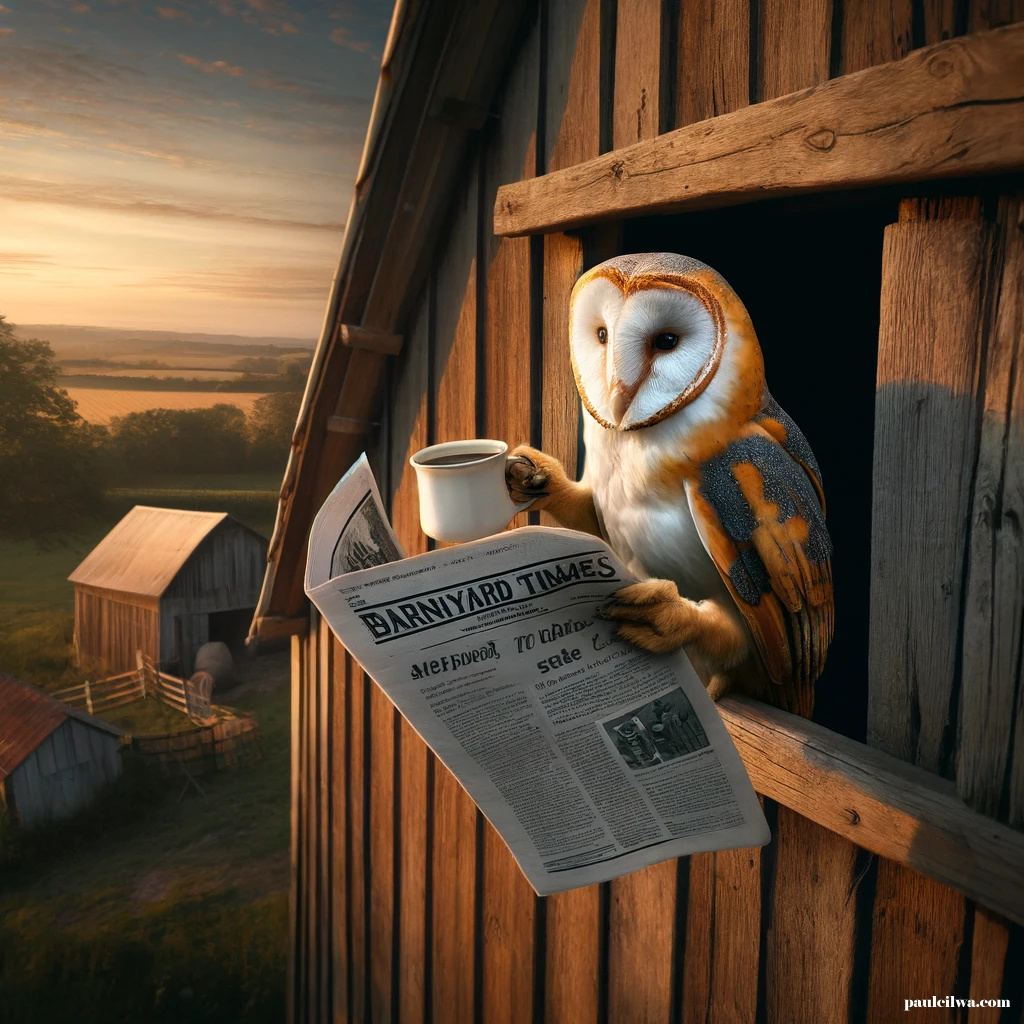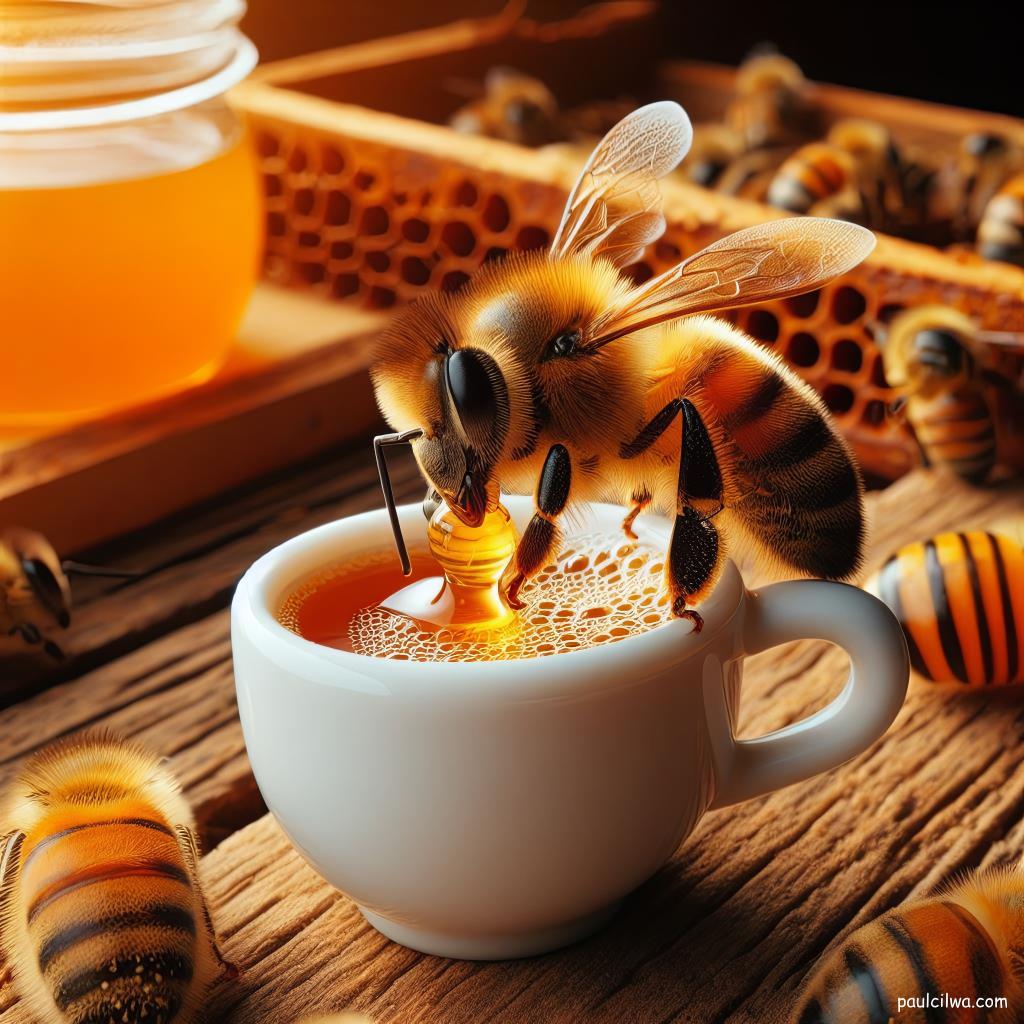| By: Paul S. Cilwa | Viewed: 5/18/2024 Occurred: 5/1/2024 |
Page Views: 215 | |
| Topics: #Autobiography #AnimalsDrinkingCoffee | |||
| Something to keep you busy as you slug down that Joe. | |||
I've been working on a series of AI pieces showing various animals drinking their morning coffee. They've been pretty popular on Facebook, where I've been sharing them on a daily basis. Here are some for you to enjoy for each of the 31 days of March!

The African Elephant, the largest land mammal on Earth, is a majestic creature whose trunk, an incredibly versatile tool, contains about 50,000 muscles and functions for breathing, smelling, and grasping, akin to a human tongue in its dexterity.

The Alligator Snapping Turtle, a prehistoric-looking behemoth, is the largest freshwater turtle in North America and one of the heaviest globally. A unique feature of this turtle is its worm-shaped appendage on the tongue, used to lure prey—a rare example of a reptile using such a sophisticated hunting technique. They can live up to 70 years in captivity and are known for their powerful bite, capable of snapping a broomstick in half!

The Arctic Fox, known for its stark white winter coat that turns to brown or gray in the summer, is a small and resilient predator native to the Arctic regions. The Arctic Fox is its ability to survive extreme cold, not just through its insulating fur but also due to its dark skin, which absorbs and retains heat more efficiently.

Armadillos are unique mammals known for their leathery armor shell, primarily found in North, Central, and South America. A curious fact about these creatures is that the nine-banded armadillo always gives birth to identical quadruplets, all originating from a single egg!

The Axolotl, scientifically known as Ambystoma mexicanum, is a fascinating type of salamander that retains its larval features, such as external gills, into adulthood and is found exclusively in Lake Xochimilco within Mexico City. One intriguing fact about the Axolotl is its remarkable regenerative abilities: it can regenerate not just limbs but also vital parts of its brain, making it a valuable species for scientific research and medicine.

The Aye-Aye is a nocturnal lemur native to Madagascar, recognized by its distinctive large eyes, slender fingers, and bushy tail that is longer than its body. An intriguing aspect of the Aye-Aye is its unique foraging method known as percussive foraging, where it taps on trees to locate grubs and then uses its elongated middle finger to extract them, a technique shared only with the woodpecker!

The Barn Owl is a ghostly pale, nocturnal bird of prey, known for its silent flight and distinctive heart-shaped face, hunting in open fields and meadows by night. A fascinating fact about Barn Owls is that they can hunt their prey in complete darkness, relying solely on their acute hearing, without needing any light at all!

The Bison is a large, humpbacked herbivore native to North America, with a distinctive brown shaggy coat. A curious fact about bison is that their massive heads and strong neck muscles are adapted for plowing through snow to reach grass, and they can run up to 35 miles per hour despite their size!

The term Black Panther refers to melanistic variants of several species of larger cats, which are not one but several distinct species that have a genetic mutation causing a black coat. Black panthers in Asia and Africa are leopards (Panthera pardus), and those in the Americas are jaguars (Panthera onca).

The Blue Jay is an easily recognizable bird with a bright blue crest, wings, and tail, and is known for its intelligence and complex social systems. Interestingly, their blue feathers arent actually blue! Its due to light scattering caused by a unique pattern in their feathers; and if you were to crush those feathers, they would appear brown.

The Blue Whale is the largest animal ever known to have existed, reaching lengths of up to 100 feet and weighing as much as 200 tons. A blue whale's heart can weigh as much as an automobile, and its tongue alone can weigh as much as an elephant!

The Brontosaurus, meaning thunder lizard, was a massive herbivorous dinosaur with a long neck and tail, living during the Late Jurassic period. A notable fact about Brontosaurus is that it was once thought to be the same as Apatosaurus, but thanks to modern DNA techniques, a 2015 study declared it to be a separate genus.

The Brown Bear, scientifically known as Ursus arctos, is a large and powerful mammal found across the northern hemisphere, with a coat that can vary from brown to nearly black. These bears have a distinctive hump at the top of their shoulder, which is actually a muscle that aids in digging dens and is unique to this species.

Caimans are a group of Central and South American reptiles related to alligators, known for their amphibious lifestyle and carnivorous diet, living along the edges of rivers and other bodies of water. They are often seen in the company of butterflies, who drink the caimans' tears for the salt.

The Australian Cattle Dog is a robust, intelligent breed of herding dog developed in Australia for driving cattle over long distances across rough terrain. From its DNA we know that it descends from the wild dingo, but the exact method of their historical breeding still remains a mystery.

Everyone knows the Cheetah is the fastest land animal, capable of reaching speeds up to 70 miles per hour in short bursts covering distances up to 1,500 feet. A lesser-known fact about cheetahs is that they cannot roar; instead, they communicate with a variety of vocalizations, including purrs, bleats, barks, hisses, and chirps.

Chipmunks are small, nimble rodents with distinctive stripes and large cheek pouches. Interestingly, chipmunks are solitary creatures but do talk with their neighbors through bird-like chirps, especially to warn of predators or claim territory.

Clownfish, or anemonefish, are vibrant marine fish known for their symbiotic relationship with sea anemones, which provide them with protection from predators. A curious fact about clownfish is that they are all born male, and some have the ability to change their sex to become the dominant female of the group.

The Dodo was a flightless bird native to Mauritius, with a large body, stout yellow legs, and a distinctive hooked beak. The dodo laid only one egg at a time, which wasn't a problem due to the lack of natural predators, but which contributed to its vulnerability and eventual extinction after the arrival of humans to their island.

The Dolphin is a highly intelligent marine mammal, recognizable by its curved mouth that gives it a permanent smile appearance. A fascinating fact about dolphins is that they replace 90% of the air in their lungs with fresh air when they take a breath, compared to humans who replace only 15%!

The Emperor Tamarin is a small monkey known for its long, white mustache. Despite their small size, they have a complex social structure and often form units of up to 15 individuals.

The English Cream Golden Retriever is a variant of the Golden Retriever breed, distinguished by its pale, creamy white coat. They are known for their friendly and trustworthy nature; but they are not actually rare, despite what some breeders may claim.

Extraterrestrials, that is, beings originating from worlds other than Earth, are likely to have diverse forms, ranging from humanoid to forms beyond our ability to imagine. Such beings might communicate through methods alien to us, such as telepathy or complex bio-luminescent signals, reflecting the vast potential diversity of life in the universe. Also, presumably there would be the extraterrestrial equivalent of dogs and mice. But surely all would enjoy coffee!

The French Bulldog, or Frenchie, is a small, muscular dog with a smooth coat, known for its bat-like ears and affectionate nature. However, French Bulldogs were first bred in England, not France, where they first became popular with lace workers in Nottingham.

The Giraffe is the tallest living terrestrial animal, with a long neck and distinctive coat pattern of irregular brown patches. A unique fact about giraffes is that their spots are as unique as human fingerprints, and no two giraffes have the same pattern.

The Hedgehog is a small, spiny mammal known for its distinctive coat of sharp spines and its ability to roll into a ball as a defense mechanism. Hedgehogs have the ability to hibernate, which allows them to survive in cold climates by slowing down their metabolism.

The Hippopotamus, or river horse, is a large, mostly aquatic mammal native to sub-Saharan Africa, recognized for its barrel-shaped torso, enormous mouth, and ivory canine teeth. Despite their hefty size, they can run at speeds of up to 30 miles per hour on land!

The Honeybee, a vital pollinator, is known for its role in
agriculture and (obviously) producing honey. These social insects
communicate through a complex system of dance to relay information
about food sources. Intriguingly, honeybees have five eyes two large
compound eyes and three smaller ocelli
eyes for detecting
light intensity.

The Horse is a large, domesticated ungulate, historically used for transportation and work, as well as companionship. Horses have the largest eyes of any land mammal, which provides them with a wide field of vision.

The Indian Elephant, a subspecies of the Asian elephant, is notable
for its smaller ears compared to its African relatives and its
significant role in the culture and mythology of the Indian
subcontinent. All elephants, by the way, exhibit handedness
with their trunks. One of their tusks will be shorter than the other,
because the elephant's truck wears it away more than the other, since
they use it in that direction more often.

The Monarch Butterfly is a vibrant orange and black winged insect, celebrated for its impressive migration across North America. The Monarch is capable of migrating up to 3,000 miles to its wintering grounds in Mexico, a journey that is unparalleled in the insect world.





